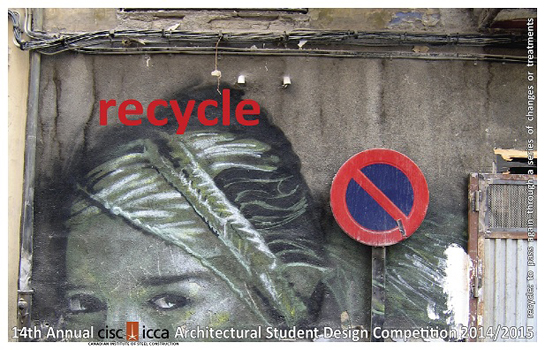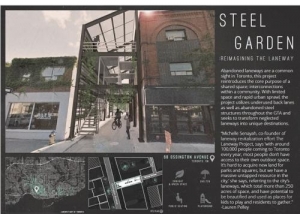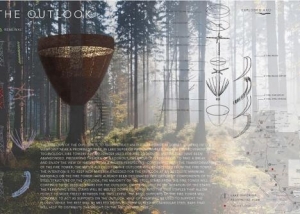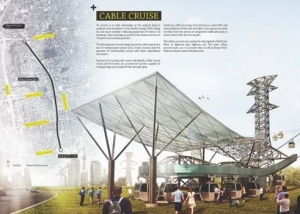2014- 2015
Finalists
Project Title | Student(s) | University | Faculty Sponsor(s) | Award |
| Cable Cruise | Tsz Kit Justin Ng, Tristan Cheong Ping Sito | University of Waterloo | Terri Meyer Boake & Matthew Spremulli | Award of Excellence |
| Steel Garden | Jane Hung, Winona Li, Sean Quach | University of Waterloo | Terri Meyer Boake & Matthew Spremulli | Award of Merit |
| The Outlook | Christy Cheng & Shaina Coulter | University of Waterloo | Terri Meyer Boake & Matthew Spremulli | Award of Merit |
| Alternative Current | Conrad Speckert, Genna Kalvaitis, Michelle Sprackman | University of Waterloo | Terri Meyer Boake & Matthew Spremulli | Top 10 |
| craneWALK | Olivera Neskovic, Liga Brammanis | University of Waterloo | Terri Meyer Boake & Matthew Spremulli | Top 10 |
| Helical Bridge | Yuri Shin, Mariam Elzein, Jason Glionna, Arnel Espanol | Ryerson University | Vincent Hui | Top 10 |
| Nexus | John Benner, Erik Aquino, Adrian Chu | Ryerson University | Vincent Hui | Top 10 |
| Recharge | April Battenfelder, Caitlyn Bidochka, Olivia Cheng | University of Calgary | Brad Braun | Top 10 |
| Reshaping the Ruins | Emma Moseley, Jasdeep Multani | University of Waterloo | Terri Meyer Boake & Matthew Spremulli | Top 10 |
| REVOLVE | Dorothy Johns, Kyle Marren, Whitney Palmer | University of Calgary | Brad Braun | Top 10 |
Judging Panel
Tim Verhey – Walters Inc.
Carol Kleinfledt – Kleinfeldt Mychajlowycz Architects
Neb Erakovic – CH2M Hill
Loraine Fowlow – University of Calgary
The Challenge
The term recycle is synonymous with steel. In a recent article in Canadian Architect, Dr. Sylvie Boulanger writes:
“Recovery implies reuse of an existing structure or recycling of steel products, extending the sustainable life of a structure and the material through multiple recovery cycles, thereby honouring the “from cradle to cradle” concept. Reusing steel involves both reusing steel in situ, dismantling a structure so it can be rebuilt elsewhere or reusing steel members and elements from a demolition site for a new building. Recycling means taking the steel members from an old structure or steel from defunct automobiles, appliances and industrial wastes, and making new steel from it, by re-melting in a furnace. Recovery strategies should be considered not only at the end of a structure’s life, as it is commonly done, but they should be integrated from the onset during the conceptual phase i.e.: What will the second life of the structure be? What will be recovered? Will it have a third and fourth life? What must be integrated at the design stage to facilitate recovery? And where would one start if one wanted to bring in reused steel in a project?”
While the capacity of steel to be recycled suggests several avenues of investigation, the definitions of recycle allude to a range of alternative interpretations. The incorporation of recycle as the theme for this year’s competition is not intended to be restrictive in scope – rather it is intended to spark an investigation into the possibilities of recycle as a conceptual incubator. Students are not restricted to designs that explore the meaning of recycle as it may be expressed within the concept of reuse, reduce & recycle; rather, they are invited to engage in the exploration of recycle as an architectural and structural concept. While they may range from utilitarian to exquisite in their execution, all responses must come to terms with one simple problem: the clear incorporation of recycle in a design that utilizes steel as the primary element for structural form.
Competition Statement
The intention of this design competition is primarily to provide students of architecture in Canada with a unique opportunity: to enter into a design process that brings together, of necessity, concept and reality. It is important for students of architecture to grasp the fact that structural design lies not just in the realm of the engineer, but can be a means for architects of arriving at a meaningful realization of architectural ideas. It is when theory meets physical necessity that architecture can become really interesting.
To that end, this competition calls upon students to conceptualize, and realize in detail, a structure of simple program that explores the meaning of recycle. The exploration will, of course, include issues related to program and site, but the emphasis in this competition is upon the architectural exploration through form and material, on the essential relationship between architecture and structure.
The reality of this competition comes in two forms: through the requirement for buildable details, primarily utilizing structural steel; and through the collaboration with the steel fabrication industry on those details. This collaboration is an important component of this competition, as a secondary objective is to expose students to both the opportunities and restraints inherent in realizing conceptual design.
The conceptual component of this competition will come through the recommendation that this competition be run through either a studio, or a lecture based course, most probably within a structures course. Under the guidance of faculty sponsors, students will conduct the design process as an academic exercise, within the guidelines set out in this brief. As an academic project, the design process will adhere to the standards set forth by the students’ school of architecture.




